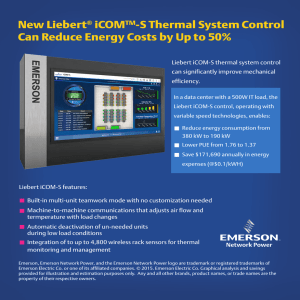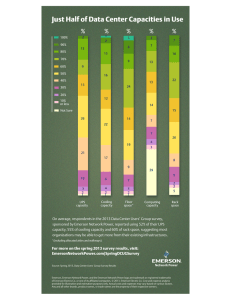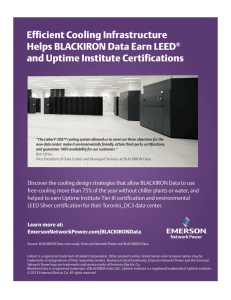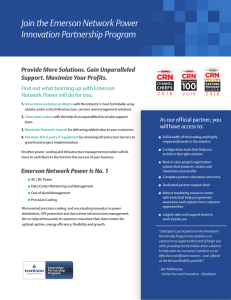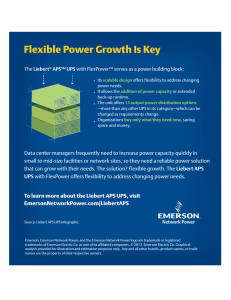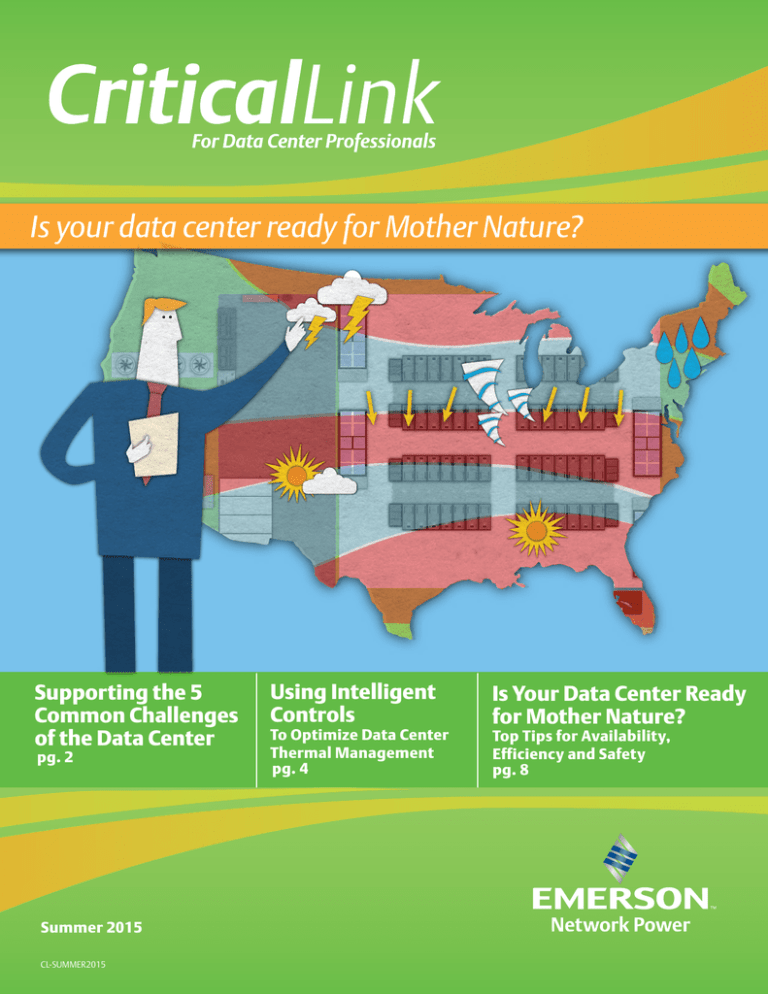
Is your data center ready for Mother Nature?
Supporting the 5
Common Challenges
of the Data Center
pg. 2
Summer 2015
CL-SUMMER2015
Using Intelligent
Controls
To Optimize Data Center
Thermal Management
pg. 4
Is Your Data Center Ready
for Mother Nature?
Top Tips for Availability,
Efficiency and Safety
pg. 8
Preparing for
the future – short
term and long term
In this issue of
Supporting the
5 Common Challenges
of the Data Center
CriticalLink, we are
focusing on the future –
summer 2015 through
2025. As summer
heats up, it seems the
weather changes as
quickly as the needs of our customers. How
can data centers plan for the future, when
there is so much uncertainty and change?
Staying on top of industry changes, new
technologies and latest thinking is the best
way to prepare for a dynamic infrastructure
that enables your critical spaces to be more
secure, resilient, flexible and efficient. You
can get started with some of the ideas and
approaches in this issue:
• Get your staff and facilities ready for hot,
humid, stormy weather
• Research of today’s IT challenges, and
how they will affect the data center of
the future
• New industry standards that are impacting
the performance of the IT infrastructure
• Equipment that enables improved
intelligence and management for
applications of all sizes
If you have questions about any of the ideas
or technologies presented here, please
talk to your Local Business Partner, or visit
EmersonNetworkPower.com
Wishing you a safe and productive summer.
Steve Hassell
President, Data Center Solutions
Emerson Network Power
t Emerson, our customers come first. A critical component
of making that possible is by actively listening to data
center professionals about what they need to be successful
in their roles. We speak to our customers in many different ways —
surveys, focus groups, advisory boards, the Data Center Users Group
(DCUG) and most recently through our Data Center 2025 initiative.
One of the key themes we’ve heard is the challenge of the data
center keeping up with demands of the business it supports.
Addressing unexpected or changing business IT needs on time
and on budget is how our profession measures success. Our vision
is a “data center as dynamic as your business”. We’re developing
integrated technologies and design approaches to address key
challenges faced by today’s dynamic business environment. The
challenges facing the business and data center can be categorized
into a few main categories:
Speed
Where once enterprises built out capacity to meet future
requirements, the drain on capital and operating costs
inherent in that approach,
combined with the pace of
change, have rendered it
impractical. Today, enterprises
need to deploy new applications
quickly and not just through
the cloud. Cloud services have
a place in the enterprise but
their value has to extend beyond
speed of deployment. Ideally,
enterprise data centers can
Contents
Supporting the 5 Common Challenges
of the Data Center
2
Using Intelligent Controls to Optimize
Data Center Thermal Management
4
Cambridge University Makes the Grade through
Consolidation with the Trellis™ Platform
6
Green House Data Chooses High
Efficiency Cooling to Achieve 1.14 PUE
7
for Data Center Professionals
deploy applications on-premise fast enough to make decisions
about when to use cloud services independent of speed. In
other words, using cloud services where it makes the most
strategic sense and not just because it enables
faster deployment.
Availability
This has been priority No. 1 for most data center
professionals for most of their careers. However,
managing availability is becoming more complex
in the current ecosystem. In some cases, it may not be about
building a five-nines facility; it is about matching availability
requirements to the needs of the application so that an
appropriate level of availability can be provided at the lowest
cost possible based on the criticality of the application. In
addition, there is now more opportunity to transfer loads
across the data center ecosystem in the event of failure, which is
creating more flexibility in how availability is managed.
“As a CIO, I operated on the premise that you
get yelled at for efficiency issues and fired for
availability issues.”
Steve Hassell, Emerson Network Power
Productivity
Of the 800-plus professionals who participated
in the Data Center 2025 survey, 44 percent don’t
expect to be working in the field in ten years. As
an industry, we need to work aggressively to train the next
generation of data center managers, while also ensuring that
the personnel working in data centers are using appropriate
tools and being as productive as they can be. This is an
aspect of efficiency that sometimes doesn’t get enough
attention. We aren’t going to be able to get the most from
our resources, or attract the best talent to our industry, if
we are managing assets in spreadsheets and monitoring
equipment by walking the floor.
Top Tips for Availability, Efficiency, Safety
8
Redfish to Make a Big Splash in Data Center
Systems Management
10
Raise Your Standards for Desktop Security
11
Are You Meeting Your Remote IT Goals?
Score a Better Solution
12
Best Practices for Creating an Effective Program
for Electrical Power Infrastructures
14
New Offerings
15
Cost
While reducing costs takes a backseat to supporting
agility, nobody has unlimited budgets and IT can’t
afford to be seen as inefficient or bloated. It limits
the ability to acquire necessary resources and prevents IT
from being perceived as a strategic partner with other areas
of the business. Externally the perception of an inefficient
energy-wasting operation can bring negative publicity and,
from an industry perspective, invite regulation.
Risk
Events in recent years have highlighted
vulnerabilities in data center systems, that when
exploited, create huge business losses. IT security has been
siloed in many organizations, but forward-thinking, risksensitive businesses now realize data center management
must be security savvy and that data center systems must be
part of a comprehensive security strategy.
Steve Hassell, Emerson Network Power president and former
CIO at Emerson and two other companies, says: “What is
interesting to me as a former CIO is that all five of these issues
ladder up to one larger concern. Vendors love to ask CIOs
“what keeps you up at night?” My answer to that question was
always: it’s not the tactical management issues I spend my day
on, it is the fear that IT, when we are needed most, will be an
inhibitor rather than an enabler of what the business needs to
accomplish. All five of these issues, if not managed effectively,
can prevent IT from enabling necessary business change.”
Read more of our latest thinking on our blog:
EmersonNetworkPower.com/Blog
CriticalLink for Data Center Professionals is a quarterly
publication from Emerson Network Power with insights and
information to help you make your data center as dynamic as
your business.
We invite your feedback on the publication and your ideas for
future articles.
Please contact us via email at:MarketingHelp@Emerson.com
To contact an Emerson Network Power representative
please go to: www.EmersonNetworkPower.com/ContactUs
EmersonNetworkPower.com
Summer 2015
3
for Data Center Professionals
Using Intelligent Controls to Optimize
Data Center Thermal Management
B
usinesses are adopting a number of new thermal management strategies to remove heat from
the data center, with a goal of also achieving capital and operational savings. One of the strategies
proving most effective is enabling greater availability, efficiency and decision making by optimizing
existing thermal management systems with intelligence provided by sophisticated controls.
“Sophisticated” doesn’t have to mean expensive, or require a significant new purchase. A large amount of
functionality is built into the current generation of thermal management controls that are integrated into
many of the thermal management systems found in data centers today. In many cases, they simply need to
be “turned on” and utilized to realize benefits. And, for those systems that do have older generation controls,
retrofit options are often available.
Look for intelligent controls that can offer these efficiency
and management features to a data center:
Match cooling to the amount of heat generated by the
IT equipment - Over cooling the data center will waste
energy and decrease the cooling unit efficiency. Under
cooling will reduce reliability of the IT equipment within
the data center.
Intelligent controls enable data centers to more easily
reach and maintain the optimal balance point of matched
cooling capacity and IT load. They accomplish this
by monitoring the data center environment through
wireless sensors and controlling the operation of thermal
management systems. The systems dynamically adjust
airflow patterns by controlling the speed of EC plug fans
or variable speed drives within the thermal management
units to allow cooling unit capacities to adapt quickly to
changing room conditions.
Utilizing intelligent control capabilities with data center
thermal management systems can yield up to 50 percent
higher cooling energy savings, depending on data
center specifications and existing equipment. Intelligent
controls integrated into the next generation of thermal
management solutions (new economizers, custom air
handling units and free cooling chillers) have been shown
to help push PUE down to between 1.05 and 1.2.
4
Summer 2015
EmersonNetworkPower.com
for Data Center Professionals
M2M COLLABORATION TO CUT
COOLING COSTS & INCREASE UPTIME.
THAT’S THE
Enable machine-to-machine communication between
multiple units to prevent them from working at crosspurposes and allow the system as a whole to adapt to
changes in facility-level demand as efficiently as possible.
Four units with variable capacity fans in teamwork mode
can operate 56 percent more efficiently than four fixed
speed units operating autonomously. At extremely low
loads, the controls can place some units in standby mode
for further savings.
There are a number of fundamental steps data center
managers can take to ensure their thermal management
systems are intelligent and self-optimizing, enabling them
to achieve the highest of levels of efficiency and availability.
One of the easiest steps data center managers can take is
to implement intelligent controls – for the simple reason
that, in many cases, it is as easy as “turning on” the controls
found within many of today’s thermal management units.
Liebert® iCOM™ Thermal
System Controls Deliver Up
to 50% Higher Cooling
Efficiency for the Data Center
The all-new Liebert iCOM controls are simple,
elegant solutions that use advanced algorithms and
machine-to-machine communications to protect
cooling systems, harmonize them for efficiency and
provide insight for action.
To read more about optimizing data center controls:
EmersonNetworkPower.com/WhatsCool
For more information go to:
EmersonNetworkPower.com/WhatsCool
EmersonNetworkPower.com
Summer 2015
5
Emerson. Consider it Solved., Emerson Network Power and the Emerson Network Power logo are trademarks and service marks of Emerson Electric Co. ©2015 Emerson Electric Co. All rights reserved.
Create a unified cooling environment that spans
unit and system level, and even integrates at the data
center infrastructure management level for capacity
and utilization monitoring. This type of system is most
ideal for allowing managers to protect, harmonize and
optimize thermal systems more intuitively. Features such
as auto-tuning are exceptionally helpful, as it streamlines
commissioning and enables the unit to intelligently adapt
to new IT systems or other changes in the data center.
CRITICAL
DIFFERENCE.
for Data Center Professionals
Cambridge University
Makes the Grade Through Consolidation
with the Trellis™ Platform
The Solution
For more than 800 years, England’s
Cambridge University has been one
of the world’s foremost research
institutions. The breadth of leadership
requires unified technology support
across all areas, but its IT infrastructure
hasn’t always been integrated. With
more than 200 server rooms located
around the campus across 120
departments, the university found
itself facing challenges when it came to
designing and running an integrated
Data Center Estate. IT management
was challenged to achieve higher
efficiency by virtualizing platforms and
refreshing equipment into a centralized
data center.
The Trellis platform from Emerson
virtualizing platforms and refreshing
Network Power provides DCIM (data
equipment, using the central data
center infrastructure management)
center space best, implementing
with a unified view of the IT equipment
evaporative cooling systems. In short,
from multiple vendors.
the Trellis platform makes sure that we
Cambridge University’s goals were to:
Combine the functionality
of multiple server rooms into
one facility
Reduce carbon footprint by 30%
Reduce IT energy costs by as much
as 40%
Consolidate management and
standardize service delivery
Improve security and availability
can operate the space successfully. It
pulls in all the information and helps
guide us.”
Results
Tasker has assumed control of the data
center building, and is in the process
of migrating the multiple server rooms
under the one roof. “We still face
multiple challenges before the center is
“In short, the Trellis platform
makes sure that we can operate
the space successfully. It pulls in
all the information and helps
guide us.”
Ian Tasker
Data Center Manager
Cambridge University
“We could monitor power, cooling,
IT equipment and so on. The Trellis™
department will ultimately have its
facilities located there,” he says.
“Running the Trellis platform will give us
greater visibility into the full scope
of our operations. And the better we
can monitor what’s happening, the
happens, we’ll be far closer to achieving
our goals.”
platform’s reporting capability lets us
Read the customer success story:
maximize our usage over time,” said Ian
EmersonNetworkPower.com/
Tasker, data center manager, Cambridge
CambridgeU
element in reducing the school’s power
usage effectiveness (PUE) throughout
its IT server facilities.”
Summer 2015
operating at full capacity, and not every
better we can control it. When that
University. “The Trellis platform is a key
6
“We can achieve higher efficiency by
The Situation
EmersonNetworkPower.com
for Data Center Professionals
Green House Data
Chooses High Efficiency
Cooling to Achieve 1.14 PUE
“The Liebert® air handlers allowed us to avoid building a central cooling
plant, they matched our modular build design, which is important for both
environmental and capital efficiency, and they enabled us to more tightly control
the data center temperature and humidity.”
Cortney Thompson
Green House Data, Chief Technology Officer
The Situation
Founded in 2007, cloud hosting and
colocation services provider Green
House Data has highly energy efficient,
and sustainable data centers located
across the U.S. The company provides
the high-availability infrastructure
needed for IT operations while
remaining a transparent, responsibly
operated company. When Green
House Data built a new data center
in Cheyenne, Wyoming, they wanted
the most efficient infrastructure
possible, consistent with the company’s
commitment to sustainability and
with 100 percent uptime service level
agreements to their customers–and
they must provide these benefits
economically.
Green House Data’s new data center
requirements included:
Support for a 35,000 square-foot,
five-megawatt data center
An efficient thermal management
system that would leverage cooler
outside temperatures and minimal
amounts of water 365 days of the
year–without introducing outside air
to the data center.
A solution that could efficiently and
cost effectively grow to meet data
center requirements
A system that would help the data
center meet its efficiency goal of a
1.14 PUE
The Solution
Working closely with Green House Data,
Emerson Network Power leveraged their
industry-leading engineering expertise
to design, manufacture, install and
commission a thermal management
Results
The Liebert Indirect Evaporative
Freecooling air handler units
use substantially less energy
compared to conventional data
center air conditioners
The air handlers have been
instrumental in helping to push
the data center PUE down to the
target 1.14
Up to 14 additional units may be
added to match future IT capacity
system customized to meet the colo’s
Watch the video:
specific needs.
EmersonNetworkPower.com/
Deployed four 300kW Liebert Indirect
Evaporative Freecooling air handler
units, with the ability to add up to 14
more units to grow with data center
requirements. The highly efficient,
aluminum air-to-air heat exchangers
offer up to 66 percent efficiency in dry
mode, and up to 78 percent efficiency
in wet mode, resulting in a possible
mechanical PUE of less than 1.2 with
minimal water usage
GreenHouseDataVideo
Learn more about Green House Data:
http://www.greenhousedata.com/
EmersonNetworkPower.com
Summer 2015
7
for Data Center Professionals
Is your Data Center Ready for
Mother Nature?
Top Tips for Availability, Efficiency and Safety.
Along with sunny days, cookouts and vacations, summer can also deliver extremes in temperature and humidity, rain,
and storms that can cause inefficient data center performance – or even cause outages. Make sure your IT operations
are ready for anything that Mother Nature can deliver by following these tips:
Cooling/Thermal Management
Maintain your humidifiers. With cold or warm
weather, humidifiers require special attention to avoid
inconvenient or costly problems such as a clogged
drain due to mineral deposits in the humidifier pan;
electrode failure in a steam humidifier; buildup from
calcium deposits, causing the humidifier to overflow.
The fix: clean humidifiers, replace bulbs, replace steam
generating canisters, check the reverse osmosis
systems in ultrasonic humidifiers
Check/change your cooling unit filters. Proper airflow
and refrigeration maintenance keeps your system from
freezing and helps to avoid performance issues
8
Summer 2015
EmersonNetworkPower.com
Check the cooling unit refrigerant charge, and oil
quality and level. This keeps your system running,
and maximizes performance and efficiency
Clean your heat rejection unit coils, and clean or
replace evaporative media. Make sure dry coolers,
cooling towers and economizers are maintained and
operating at peak performance
Check for vegetation and debris around condensers
and dry coolers. Leaves, pollen, cottonwood and
other vegetation can be pulled into the outdoor units,
making heat rejection less effective and impacting your
data center’s capacity. Routine cleaning will keep your
systems operating efficiently
for Data Center Professionals
Manage control setpoints. Make the necessary
adjustments for changes in heat and humidity, to prevent
condensation, IT equipment failure, or shortened
equipment life
Consider intelligent controls. Newer control systems
can impact efficiency and visibility, with benefits such as
automatically adjusting to maximize free cooling hours
for economizer systems; controlling multiple cooling units
to work in harmony; and providing reports that allow for
managed adjustments and planning
Talk to cooling experts. Fine tuning of your controls
can have a major impact on uptime and efficiency with
the right expertise, you can maximize your system’s
performance and efficiency with proper return air
temperature, heat rejection setpoints, economization
setpoints, humidity/dewpoint setpoints, and an
assessment of your vapor barrier
Power Management
Investigate your generator control settings – the
wrong settings might drain your UPS system batteries.
Thunderstorms are a special challenge for generator
operation. Severe storms can cause utility re-closures,
which look like short duration outages to the utility. If
the generator controls are set to auto-retransfer back to
the UPS after the utility returns, the system may be using
battery energy with each transfer, possibly leaving no
battery run time for the next transfer or for a sustained
outage. The fix: some operators use a storm scope to
assess weather activity, choosing to proactively transfer to
generator operation and stay in this mode until the storm
clears, resulting in a controlled transfer that saves battery
life for a true emergency
Maintain backup generators. Perform preventive
maintenance, test and fuel up so your backup system is
ready for a sustained outage
Monitor the health of UPS batteries, and replace bad or
suspect batteries. Keep spares on hand
Monitoring
Data Center Management
Perform emergency drills for data center staff.
Preparedness drills can help you identify holes in your
emergency plan so you can make adjustments before an
urgent situation
Make sure staff knows all emergency numbers and your
emergency escalation plan
Set up automatic notifications of alarms/alerts for
problems with your IT support systems
Have an offsite backup location – and back up the data
on schedule
Set up notifications for clients/tenants to let them
know how their data is being protected and how it
can be accessed
Keep food, drinks and other emergency supplies on
site for data center personnel who provide support
during emergencies
Do you have some good tips on preparing for weather
challenges? Let us know at MarketingHelp@Emerson.com
ALWAYS ECONOMICAL.
ALWAYS THE RIGHT CAPACITY.
ALWAYS THE RIGHT SIZE.
THAT’S THE
CRITICAL DIFFERENCE.
The new Liebert® eXM™ UPS
The right choice for midsize power protection.
Highly Efficient. Small Footprint.
Expandable through paralleling.
10-200 kVA.
For more information go to:
EmersonNetworkPower.com/LieberteXM
Monitor for heat, humidity and water leakages that can
impact IT equipment or infrastructure
Engage your infrastructure provider for remote
infrastructure monitoring, phone resolution and
emergency service
EmersonNetworkPower.com
Summer 2015
9
for Data Center Professionals
Redfish
to Make a Big Splash in Data
Center Systems Management
T
echnology industry leaders Dell, Emerson Network Power, HP
and Intel have worked together to create Redfish, a new
specification under development for data center and systems
management. This effort leverages the experience of the team in IT
systems hardware, microprocessors and data center infrastructure
management technologies.
One of the most comprehensive specifications since the
Intelligent Platform Management Interface (IPMI) was
launched in 1998, Redfish uses a modern network
interface style, allowing access to data using even
simple, script-based programming methods.
The Redfish specification will:
Improve scalability
Expand data access and analysis.
Help lower costs
Further enable feature-rich remote management
Ensure a secure solution that protects investment.
Enhance interoperability across multiple server
environments and significantly simplify management,
allowing administrators to speak one language and be
more productive.
Enable access to massive amounts of information and efficiently
translate the data into actionable insights for system monitoring
and management.
The businesses are working with industry standards bodies and associations
to accelerate the development process, in anticipation of broad adoption of
Redfish. The specification will be submitted to the Distributed Management
Task Force for consideration by the recently created Scalable Platform
Management Forum, which has been chartered to publish a standard in this
space. Once the specification is approved, it will be publicly available.
10
Summer 2015
EmersonNetworkPower.com
for Data Center Professionals
Raise your
standards for
desktop security
Y
ou have probably seen it in the headlines and in the
movies - security threats that can sneak through the
backdoor of computer peripherals and result in loss
of intellectual property, privacy and identity. The Boston
Globe reports: Workers scattered across more than a dozen
agencies, from the Defense and Education departments to
the National Weather Service, are responsible for at least half
of the federal cyberincidents reported each year since 2010,
They have clicked links in bogus phishing e-mails, opened
malware-laden websites, and been tricked by scammers into
sharing information, according to an Associated Press analysis
of records.1
Analog audio diodes to prevent audio eavesdropping
(TEMPEST levels).
Emulation of display EDID, keyboard and mouse to avoid
direct contact between computers and shared peripherals.
Strong protection from social attacks and malicious USB
devices (such as BadUSB).
And much more
Security must be included in the initial design of the
product. This provides more focus on security than seen in
previous Peripheral Sharing Switch Protection Profiles.
Defense News Leadership poll respondents:
The greatest threat to the United States
Source: http://archive.defensenews.com/section/static26/
45.1 % Cyberwarfare
26.3% Terrorism
But new improvements to protection profile standards are
helping data centers increase desktop security and prevent
these costly attacks.
On February 13, 2015, the National Information Assurance
Partnership (NIAP) released the latest version of the
Protection Profile for Peripheral Sharing Switch version 3.0
(PP 3.0), which includes security enhancements for modern
peripheral switching technology.
Product range has increased. PP 3.0 supports a vast
number of new products that can be tested for use in secure
environments. These products include regular KVM switches,
KVM combiners, Video wall processors, Matrix KVM and many
other devices.
Emerson Network Power played a key role in developing PP
3.0 by serving in the Technical Community and writing key
pieces of the requirements. By understanding the direction in
which the Technical Community was heading, Emerson has
been able to design new products that will meet PP 3.0. Here
are some highlights of the new standard:
Stronger testing replaces Evaluation Assurance Levels
(EAL). Thirty times more testing is required in PP 3.0 than
there has been in previous Protection Profiles.
The definitions of the threats and functions to prevent/
propagate attacks have been updated. PP 3.0, standards
are defined to defend against evolving, advanced threats and
provide assurance that the switch will not propagate attacks if
they occur. Changes include:
Higher isolation between computer ports from digital
and analog leakages.
Optical data diodes to enforce unidirectional data flows.
Much stronger protection for USB ports.
Complete isolation of power domains to prevent
signaling attacks.
1) http://www.bostonglobe.com/news/nation/2014/11/10/federal-governmentstruggles-against-cyberattacks/8ls3WW4Q5baJ9iIO5DPqfM/story.html
Future-proof technology is added. PP 3.0 includes support
for the most modern KVM technology including: USB (USB
1.1, 2.0, 3.0 and Type C); HDMI and DisplayPort video; MHL to
support mobile devices and not only computers.
PP 3.0 is internationally recognized. A true joint
international effort, PP 3.0 passed through agencies and
certification bodies in Canada, UK, Australia, Japan,
Germany, France, Italy, Spain, Poland, Greece, Turkey, Israel,
NATO and Brazil.
To learn more about NIAP PP 3.0 standards, visit
EmersonNetworkPower.com/AvocentKVMPress
To learn more about new, compliant KVM technologies:
EmersonNetworkPower.com/AvocentKVM
EmersonNetworkPower.com
Summer 2015
11
for Data Center Professionals
Are You Meeting Your
Remote IT Goals?
Score a Better Solution
If you have a network closet, computerized
point of purchase system, ATM or mobile
workstation, then you have an application
that falls into the large and growing number
of remote or edge-of-IT applications. While
these sites are small, they are growing in
importance–and they come with their own set
of unique challenges.
Remote but resilient. Businesses depend
on this distributed computing to have the
same availability as a large, central data
center. This means you have to treat power,
heat and communications like a big data
center, but on a smaller scale. Choose
reliable technologies that offer service and
maintenance support.
Quick deployment. Remote sites require
support equipment to be easy to select,
quick to install, and ideally not a drain to
your employee resources to get things up
and running.
Visibility and Control. It can be difficult
to see what’s happening with power
and support equipment at the edge
of the network. Similar to a large data
center, remote IT needs a comprehensive
monitoring and management solution to
ensure continuous operation, with minimal
time and effort from IT staff.
Budget conscious. Supporting multiple
remote locations can be hard on your IT
budget. Select solutions that offer a lower
first cost and reduced operating, but with
high reliability to minimize downtime costs.
12
Summer 2015
EmersonNetworkPower.com
Here are some effective, efficient and manageable solutions that can
address the challenges of remote/edge applications:
Liebert® GXT4™ UPS
Designed for optimized resiliency, efficiency and speed of
deployment, this true on-line, rack/tower convertible UPS
provides protection from all power anomalies.
500 - 10,000 VA
Rack/Tower convertible
Bypass, Battery, Distribution, Environmental Monitoring Options
Centralized monitoring and control compatible
ENERGY STAR® qualified models
Available with Power Assurance Package
For more information:
EmersonNetworkPower.com/LiebertGXT4
Liebert APS™ UPS
Scalable, true on-line UPS provides protection from all
power anomalies, while offering the ability to grow with
your compute needs.
5 - 20 kVA
Scalable Design
Rack or Floormount
Bypass, Battery, Distribution, Environmental Monitoring Options
Centralized monitoring and control compatible.
ENERGY STAR® qualified models available
For more information:
EmersonNetworkPower.com/LiebertAPS
for Data Center Professionals
Power Assurance Package
This lifecycle power
management solution
for network edge UPS
systems helps to reduce
IT responsibilities and save time and
money. The package eliminates the
worry surrounding power performance,
installation, disposal, emergency parts,
labor, travel and maintenance.
5-Year Protection Plan
Installation, Startup
Old UPS/Battery Disposal
Parts, Labor, Travel
MPH2™ Managed
Rack PDU
The most intelligent, highavailability line of managed
rack PDUs, MPH2 offers
the industry’s leading
operating temperatures,
ensuring availability
even in the harsh environment at the
back of the rack. MPH2 offers remote
monitoring and control capabilities as
well as environmental input options,
with multiple power input selections
and output configurations.
Compatible with environmental
sensors
Modular, hot-swappable
controller card
For more information:
EmersonNetworkPower.com/
MPH2
Avocent® KVM solutions
A wide selection of
KVM to meet specific
site requirements.
Includes proven, secure solutions for
guarding against cyber intrusion at the
desktop. Switches are available that
are designed to meet stringent U.S.
government specification, and comply
with the requirements of the latest NAIP
protection profile for peripheral sharing
devices 3.0.
Integrated Infrastructure Solutions:
SmartCabinet™ is a
turn-key solution that
contains supporting
infrastructure for branch IT
applications – secure cabinet, power,
distribution, monitoring.
SmartRow™ is an
intelligent, integrated
infrastructure appropriate
for smaller remote sites.
The enclosed system
combines ups to six data center
racks, precision cooling, UPS, power
management, monitoring and control
technologies, and fire suppression.
Turnkey Integrated Solutions
Rack/Enclosure
Desktop and rack based KVM
Power, Distribution
Secure Desktop KVM
Cooling
K VM over IP
Monitoring
Analog KVM
Security
High performance KVM
For more information:
For more information:
EmersonNetworkPower.com/
EmersonNetworkPower.com/
SmartSolutions
KVMSelector
Horizontal and vertical models
Remote or local monitoring at the
branch level
Remote control at the
equipment level
EmersonNetworkPower.com
Summer 2015
13
for Data Center Professionals
Best Practices for
Electrical Power Infrastructures
Recent changes to NFPA’s Electrical Safety
Requirements for Data Centers
Every business values the safety and health of their
employees. One of the most impactful areas that benefit the
safety of data center employees is education on best practices
for working on or near electrical equipment.
Arcing from an electrical fault can produce temperatures
hotter than the surface of the sun, creating an incredibly hot
blast with force similar to an explosion—enough to throw a
worker’s body across the room. The National Safety Council
reports that electrical hazards like this cause nearly one
fatality every workday in the United States. And the U.S.
Bureau of Labor Statistics reports in the last 10 years, 2,000
fatal and more than 24,000 non-fatal electrical injuries such as
those sustained from an arc flash.
Because of the severe consequences of arc flash incidents,
NFPA and the Occupational Safety and Health Administration
(OSHA) are mandating and enforcing safer electrical work
practices. With the assistance of a well-qualified, professional
electrical engineering or electrical testing service provider,
facilities can efficiently and cost-effectively evaluate, update,
and maintain their electrical safety programs to ensure
compliance and a safe work environment for employees.
Emerson’s Recommended Best Practices
for Complying with NFPA 70E
14
4- Design and Methods Review. A protection scheme
design review and operational assessment of your electrical
distribution system should be conducted to identify and
reduce potential electrical hazards.
5- Accurate Single-Line Diagrams. NFPA 70E requirements
mandate accurate, up-to-date and legible single-line
diagrams. These schematics are essential for documenting,
troubleshooting, and communicating information about
your power systems.
6- Short Circuit and Coordination Studies. Short circuit and
coordination studies calculate momentary, interrupting,
and arcing current values; compare available fault currents
to protective device ratings; and establish trip settings for
all types of protective devices, which reduce unplanned
downtime or outages.
7- Electrical Safety Program Review/Development. At
a minimum, the program should identify hazard/risk
evaluation procedures, electrically safe work procedures,
tools and personal protective equipment (PPE), and risk
mitigation strategies. The electrical safety program must
be documented and audited at least every three years to
verify the principles and procedures are in compliance with
NFPA 70E.
1- Preventive Maintenance. By maintaining all electrical
equipment, you can help ensure worker safety and prevent
unplanned downtime.
8- Arc Flash Training Program and PPE Plan Development.
Developing a specific arc flash training program and
complementary PPE plan based on the findings of the arc
flash analysis can ensure workers fully understand electrical
and arc flash hazards and how to mitigate the risks.
2- Arc Flash Risk Assessment. NFPA 70E requires facility
owners to perform an arc flash risk assessment prior
to allowing a worker to perform tasks on energized
equipment.
9- Documentation. Keeping comprehensive and proper
documentation can ensure compliance with NFPA 70E and
OSHA standards and can help facilitate an investigation
should an arc flash-related injury occur.
3- Labeling and Hazard Communication Plan. Electrical
equipment such as switchboards, panelboards, industrial
control panels, and motor control centers that are likely to
require maintenance while energized, must be field marked
with a label, and the labels must be reviewed no less than
once every five years.
10- Periodic Reviews. The arc flash assessment must be
updated whenever significant changes are made to the
system, or at most, every five years.
Summer 2015
EmersonNetworkPower.com
For more information about workplace safety and NFPA 70E,
please read the white paper “Understanding 2015 Changes
to NFPA 70E”
for Data Center Professionals
New Offerings
Liebert® eXM™ midsize UPS line extended to 200kVA
The high efficiency Liebert eXM UPS family now includes five
new larger capacity models, extending the line from 10kVA/
kW to 200kVA/kW. This is good news for midsize data centers
looking for efficient, robust power solutions with lower
TCO. Features include ENERGY STAR® qualified models, and
availability of battery cabinets, centralized monitoring and life
cycle management.
EmersonNetworkPower.com/LieberteXM
Trellis™ with RESTful application programming interfaces
Trellis platform DCIM release features new RESTful APIs
(representational state transfer application programming
interfaces), enhancements to change planning capabilities,
and eight new base package reports. With these updates,
Trellis platform customers will have a fully integrated view of
their operations across both IT and facilities resources, be able
to make better capacity management decisions, and save
time and costs.
EmersonNetworkPower.com/DCIMpress
First Secure KVM and KM switches designed to meet new
NIAP IT Security guidelines
This line of new secure KVM (Keyboard, Video, Mouse) and
KM (Keyboard, Mouse) switches is designed to meet the new
NIAP PP 3.0 protection profile. In high-security environments,
these technologies help organizations streamline access to
critical information and increase productivity. The new line
of products includes the Cybex™ SC family of secure desktop
KVM and all new KM switches.
EmersonNetworkPower.com/ITSecurityPress
Enhancements to Avocent® ACS 6000 firmware, Universal
Management Gateway, DSView software, Rack Power
Manager, and KVM switches
Significant enhancements have been made across the
Avocent portfolio, ensuring best in class security capabilities
for government, multimedia, broadcast, financial and IT
operation center environments. All of the enhanced solutions
address two critical customer concerns: enhanced security
and increased remote monitoring and management
EmersonNetworkPower.com/ITSolutionsPress
Next Generation Albér® Battery Management
Software Platform
Albér Battery Xplorer software platform. This new software
improves visibility and maximizes the availability of critical
power systems dependent on stationary back-up batteries by
translating data into actionable insights that enable smarter,
faster decisions.
EmersonNetworkPower.com/AlberPress
A full suite of custom air handling solutions for the
data center
Introducing Liebert Custom Air Handling Units – the
industry’s most comprehensive line of air handling solutions
for mission critical environments. This family includes direct
evaporative free-cooling, indirect evaporative free-cooling,
chilled water, and direct expansion air handlers, all available
with Liebert iCOM™ control system.
EmersonNetworkPower.com/AHUpress
Social Media:
www www.EmersonNetworkPower.com
www.linkedin.com/company/emerson-network-power
@EmersonNetPwr
www.Facebook.com/EmersonNetworkPower
www.Gplusid.com/EmersonNetworkPower
www.YouTube.com/EmersonNetworkPower
EmersonNetworkPower.com
Summer 2015
15
CENTRALIZED DCIM, BETTER RESULTS.
THAT’S THE
CRITICAL DIFFERENCE.
See how University of Cambridge deployed
TrellisTM Platform DCIM.
EmersonNetworkPower.com/CambridgeU
Emerson. Consider it Solved., Emerson Network Power and the Emerson Network Power logo are trademarks and service marks of Emerson Electric Co. ©2015 Emerson Electric Co. All rights reserved.

